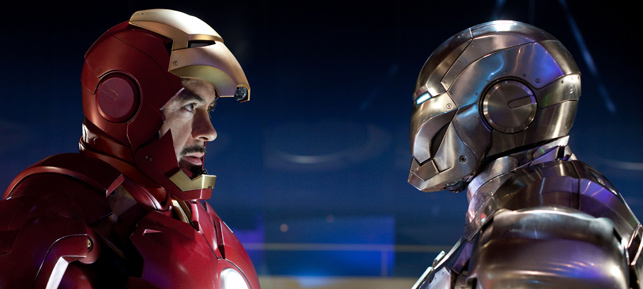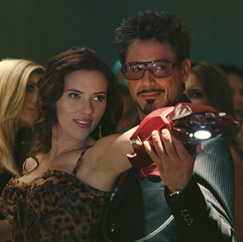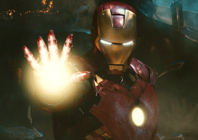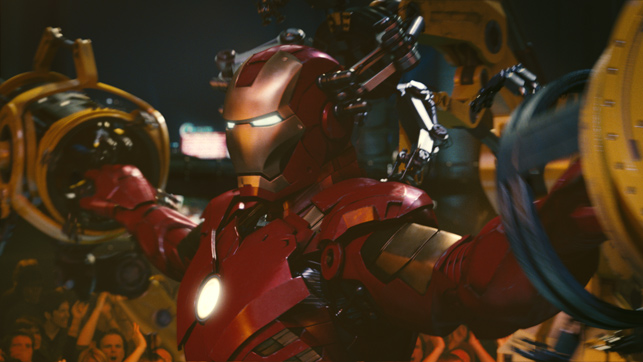
We step behind the scenes of Hollywood to find out how to build a suit fit for a superhero
With a gleaming gold and red suit of armour, pulsating with weaponry and a glowing orb set in its chest, Iron Man has returned.
The blockbuster movie of the summer is big, bright and brash; everything one would expect from the Hollywood machine pumping all it has into an action driven special effects spectacular.
Behind the world of glitz and glamour, red carpets and beautiful people is a hard working industry dealing with design issues most will never have to encounter, and that’s before we get to a superhero’s wardrobe.
Special effects are a massive part of this and none come much bigger than Legacy Effects, the progressive name for the legendary Stan Winston Studios. The projects that the company has worked on read like a list of all time great special effects films, including Terminator, Jurassic Park, and more recently Avatar.
Legacy built the suits for the original Iron Man film and the company has now followed this up with a Mark IV suit for the sequel. While Robert Downey Jr. certainly looks the part in his armoured exoskeleton, there is no Hollywood trickery when these suits are used on set.
“It was very challenging as when they film these Iron Man movies they go all the way – it’s a live action movie,” says Jason Lopes, systems engineer at Legacy Effects, fresh from finishing up another Marvel superhero movie, Thor. “They’re actually using our parts, hitting our parts, beating each other up with our products, so there’s a constant call to make more.”

Robert Downey Jr, as billionaire industrialist and master engineer, Tony Stark, AKA Iron Man
The unsung heroes
The entire process of designing and manufacturing these parts is technology driven: concept artists dive straight into 3D, CAD files are shared between the team for adjustments and editing, and rapid prototyping is used to build models from scaled down maquettes, to full size parts.
A key figure in the design team is Simon Webber, a concept artist, who via the wonders of modern technology, can be based in the UK while his compatriots work in California. Legacy works closely with the film’s director on what characters and real effects will be needed and then along with the other concept artists Weber is provided with background and sketches.
“We get notes based on the script and then we’re at a concept stage where we try out lots of varying ideas and see what lands,” says Simon. “We turn that stuff over to a director and see if anything hits the mark.
“We’re doing that three-dimensionally from the beginning, we’re not doing lots of concept art that then needs to be turned into a model or an asset later on, it’s straight into the 3D world. The changes that you make, you’re making to what will become the final asset.
“Because we’ve got experience at sculpting in the real world with clay we just go straight in with ZBrush and design it in there. It’s a quicker end result.”
Simon has over ten years of experience in practical special effects make-up, and he only moved over to digital design two years ago, but has never looked back. Now working with a Wacom tablet, using ZBrush 3.5 and Photoshop running on a Windows-driven Mac Pro, Simon is amazed at how quick and fluid the entire process is.
“It was sculpting that I was used to,” he says of the digital tools. “But I was able to illustrate from it, paint from it and you’ve then got an asset that you can do so many things with.”
The designs are sized to human proportions, and the actor who is going to wear the costume or parts is scanned in 3D so the model can be scaled to their exact proportions before any of it is built.
“The speed that you can churn out concepts and ideas, and the flexibility of being able to hand an asset over to someone and they can make changes; it’s such an editable, organic process,” continues Simon.
“You can do a design one day, then the next day you can have a bunch of parts sitting on a desk that represent that model and another day later you’ve got a full maquette in front of you, painted up that looks like your design, and a director can see it from all angles, see how he’s going to light and shoot it.”
The need for speed
The development process has been accelerated with the help of rapid prototyping techniques. First used in the production of Jurassic Park 2: The Lost World, 3D printing has since come into its own in the world of special effects.
For Iron Man 2 the team looked to Objet for its rapid production capabilities, taking on a range of printers including the Eden 260v and 500v to make sure the action-packed movie was never short of parts that were subjected to some extreme conditions on set.

Legacy Effects re-invented the way Robert Downey Jr’s chrome plated gauntlets were assembled to maximise movement
“We were responsible for the whole suits, so I did mainly the gauntlets, pieces of the boots, different pieces of the helmet and the face mask,” says Jason from Legacy’s headquarters in San Fernando, California.
“With Iron Man, the concept art was brought to us and had to be tweaked from there, and to show how to make it. A lot of these concepts, especially for the superhero genre, a physical person could not fit into a suit as such, so we’ve got the artists here and they know how to really bring the vision into reality.”
The route from concept to finished part is not always smooth and Jason had issues with the with original production gloves for Robert Downey Jr. “They just did not come out to our satisfaction the first time around and we wanted to address that,” he says.
“Once we brought the Objet in-house with its detail and accuracy we were able to redevelop our ‘gauntlets’ (what we call our gloves – the Iron Man gauntlets) and basically introduce some pretty kick-ass movement in the gloves because it’s a live-action film. So Downey Jr. had to be able to be physically able to do stuff without having the arms sacrificed.
“We re-invented the way that we assembled these gauntlets and designed them, and we were going for full gloves, which took about eighteen hours for left and right hands, to fully chrome plated, and in some instances mechanically put together in a day and used.”
With the film set located little over 20 minutes away from Legacy Effects’ design studio, and the sheer volume of action scenes in the film, you get the impression that the team was on constant call.
The list of parts goes on – pieces for Whiplash, the film’s villain played by Mickey Rourke, were printed directly for his armbands and weapons.
Back to the future
With Legacy Effects Jason has continued to progress the use of technology that began with Stan Winston’s own vision, the place where he began his career. “I actually interviewed with [Stan Winston] which was pretty intense – that was at a time when we had a different structure with the digital department. With his vision we started to create a digital department that went hand-in-hand with the traditional practical effects.

Whiplash, the villain in Iron Man II played by Mickey Rourke, didn’t actually make his own armour for
the film
“He basically wanted the department to be unlike any other department in his studio.
“We’ve pushed the envelope with the processes, but Stan’s core foundations are still behind it. We’re very meticulous to our craft and we’re doing more hands-on work.
“We have a traditional design department, and by traditional I mean we use every package out there. We have people using Maya, people using SoftImage – ZBrush is a huge part of what we do now to edit detail and the different processes that we use here now. We use Rhino, we use Modo – basically whatever an artist is comfortable with, we use.
“We even have some little techniques in house, stuff that we’ve developed over the years.
“It takes a really special artist to understand how to design something on a computer screen and bring it to real practical life.
“We take input here from all the people that work here, and even outside clients, but the job falls with me constantly looking for tools and technology that don’t take away from the art, that’s the big problem, that’s something we really stand by.
“There’s a lot of different technology out there but the minute it takes away from the art, or makes our deadlines shorter because of how complicated it is we consider it a fail, because we always want to stay true to our original vision.”
The big blue
By far the biggest project the team has undertaken was the work done for James Cameron’s epic movie Avatar.
“Avatar was on such a big scale that it was still not cost effective enough to fully print large pieces on Objet technology, but where we could we would – pieces that involve detail and stuff like that,” explains Jason.
Legacy Effects uses Objet’s Eden 3D printers – here shown printing out a Na’vi from Avatar, which James Cameron used to visualise the film’s blue skinned stars
“What’s really cool about our workflow is that we did all the Na’vis for Avatar – all the blue people if you will – and we got to digitally sculpt organic characters and then print out the small 1/8th scale models for Cameron to actually look at.”
It wasn’t all small scale, with Legacy building a giant Amp Suit, the armed mechanical walkers in the movie.
“As far as the Amp suit goes we were really proud of growing that full suit in the huge pieces – it’s ridiculously big.”
When asked for his favourite project so far, Avatar leads them all. “Avatar – by all means Avatar! The scale of things was quite demanding at times, just working with James Cameron is enough to rally you, but the sheer volume of the work that was coming through, and what was expected, and seeing the whole team just building this stuff out was pretty phenomenal.”
With a team of eight to eleven people in the digital design department, combined with upwards of 100 staff working on the shop floor, Legacy has a gargantuan amount of work. Last year alone it worked on 245 television commercials and numerous feature films.
“The commercials are so hardcore compared to the films that we have to up our game because of what we’re expected to achieve in such a little amount of time,”
says Jason.
Leaving Jason to get back to his incredibly busy job he nonchalantly mentions that next up is work on two separate projects “with Spielberg and Favreau”. The glamour of Hollywood can’t be all too bad surely?
Dryly, Jason sardonically replies, “At five’o’clock you just want done with it, you know?”
It’s just another job, but in another world.
www.legacyefx.com
www.ironmanmovie.com
We find out how Iron Man’s legendary suit was brought to the big screen






